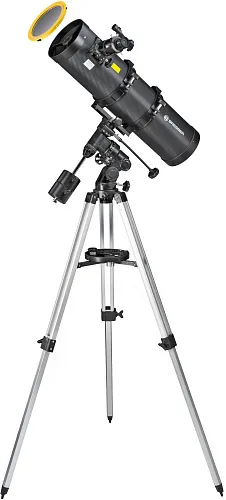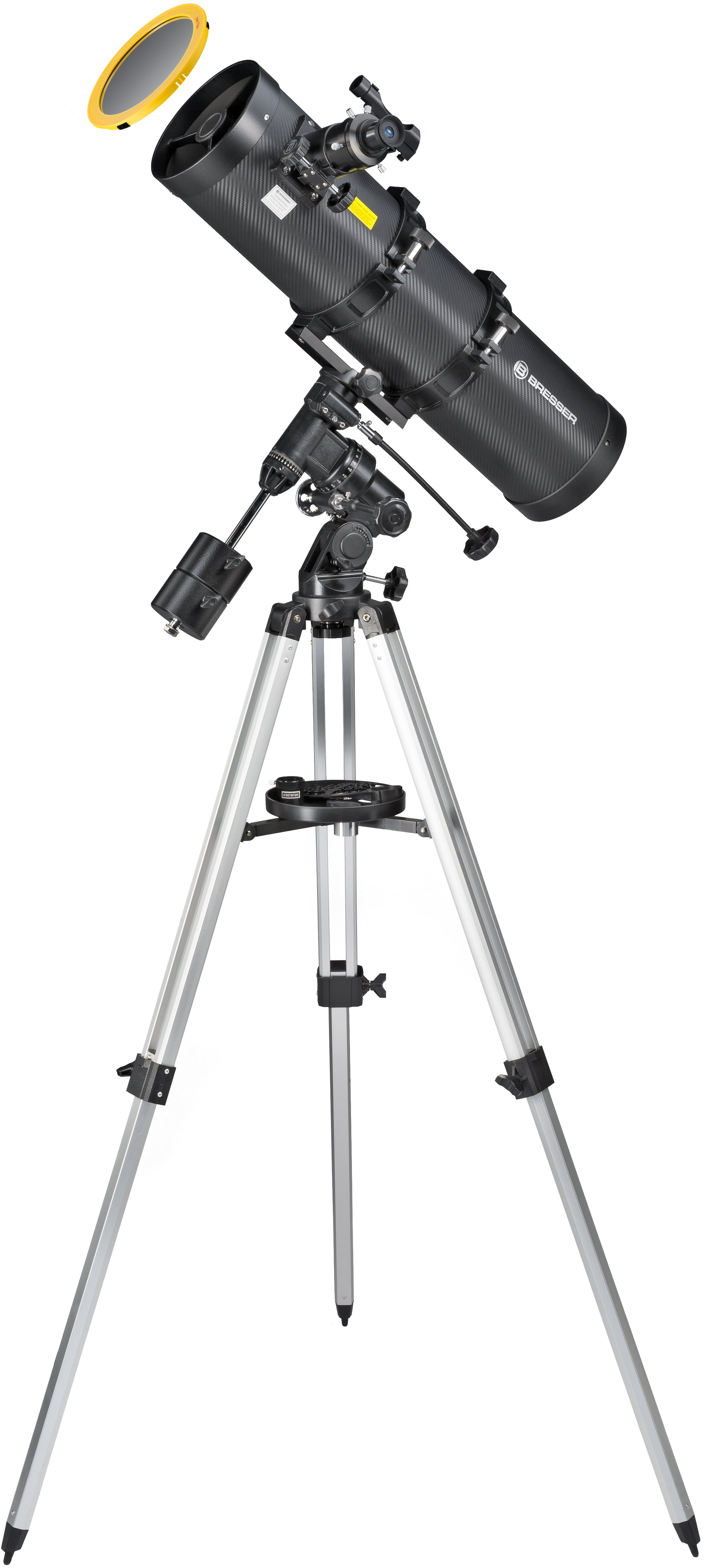Bresser Pollux 150/750 EQ3 Telescope with solar filter
Newtonian telescope. Objective lens diameter: 150mm. Focal length: 750mm
| Product ID | 74251 |
| Brand | Bresser GmbH, Germany |
| Warranty | 2 years |
| EAN | 4007922058832 |
| Package size (LxWxH) | 77x50x34 cm |
| Shipping Weight | 17.5 kg |
The large mirror with a short focal length allows the observation of many celestial objects. With this very light-gathering large field telescope, all extended objects such as star clusters and galaxies can be observed particularly well. But also moon and planets are shown very detailed. The length of the tube is despite to its short focal length kept short, that's why it is well transportable. But also the mechanic of Bresser Pollux is powerful. The equatorial mount allows every user to target the telescope. All Newton Telescopes have a drawtube on the side of their tube. It offers comfort while observing celestial objects. Explore the planets within our solar system and discover new worlds.
With the included smartphone camera adapter you can take pictures of your best observations right through the telescope.
The Bresser Pollux is also equipped with a large 2.0" focuser which allows the use of 2.0" eyepieces with even larger fields of view. The included eyepiece adapter 2.0" to 1.25" allows the use of all 1.25" eyepieces. Bresser has not saved any money and also equipped this telescope with a high-quality parabolic primary mirror. This offers a much better image in sharpness and contrast than a comparable telescope with a simple spherical mirror. In addition, this telescope has a particularly large 55mm secondary mirror for ideal illumination of the image field.
Features:
- Telescope for night and solar observation
- Optical system: parabolic Newton Reflector
- Highest practical power: 300x
- Objective lens diameter: 150mm
- Focal length: 750mm
- Aperture ratio: f/5
- Large 55mm secondary mirror
- Mounting: Equatorial EQ-3
- Eyepiece diameter: 31.7mm (1.25")
- Focuser: 2.0" with adapter for 1.25" eyepiece shaft
The kit includes:
- Telescope
- Aperture Solar-filter
- Eyepieces: 4mm, 20mm
- LED Viewfinder
- 3-fold Barlow lense
- Smartphone camera adapter
- Aluminium tripod
- Accessory tray
- Software
- User manual
| Product ID | 74251 |
| Brand | Bresser GmbH, Germany |
| Warranty | 2 years |
| EAN | 4007922058832 |
| Package size (LxWxH) | 77x50x34 cm |
| Shipping Weight | 17.5 kg |
| Optical design | reflector |
| Optical scheme | Newtonian |
| Primary mirror diameter (aperture), mm | 150 |
| Secondary mirror diameter, mm | 55 |
| Focal length, mm | 750 |
| Highest practical power, x | 300 |
| Aperture ratio | f/5 |
| Resolution threshold, arcseconds | 0.9 |
| Eyepieces | 4mm, 20mm |
| Eyepiece barrel diameter, in | 1.25 |
| Barlow lens | 3x |
| Finderscope | red dot, LED |
| Focuser | 2", with 1.25" adapter |
| Solar filter included | ✓ |
| Tripod | aluminum |
| Accessory tray | ✓ |
| Mount | equatorial, EQ3 |
| Optical tube material | metal |
| User level | beginners, experienced users |
| Assembly and installation difficulty level | easy |
| Observed object | planets of the Solar System and deep-sky objects |
and downloads
Convenient diagrams that describe how to install additional accessories on refractors and catadioptric telescopes
Find out how to assemble a telescope on an example of the Levenhuk Skyline 90x900 EQ telescope
This short guide will help you avoid typical mistakes and learn more about telescope and mounting types
The basics of astronomical observations for beginners
In this article we have gathered answers to some of the most frequently asked questions about telescopes
How telescopes work?
You can actually perform observations from your balcony!
All about telescope sizes, types, magnification, and mounts
Learn how to set up and use the telescope properly
Astronomy in light-polluted skies. Find out what you can observe in the city
Read an interesting comprehensive article on telescopes for little astronomers
Celestial objects you can observe with telescopes of different apertures
Colored and vivid images of galaxies, planets and star clusters entrance everyone who is fascinated by boundless space
Find an interesting review on the history of the changes to a refracting telescope
To make the process of choosing a telescope easier, we will tell you about the characteristics of the most popular types of telescopes today
Learn everything you need to know about refractor telescopes to make the right choice

 BG
BG  BY
BY  CY
CY  CZ
CZ  DE
DE  EE
EE  ES
ES  GR
GR  HU
HU  IS
IS  IT
IT  LT
LT  LV
LV  MY
MY  PL
PL  PT
PT  RO
RO  SK
SK  TR
TR  UA
UA  USA
USA 








